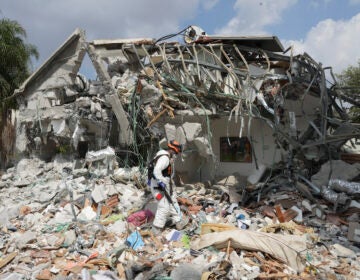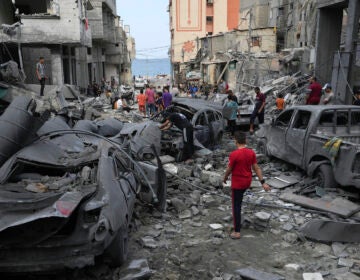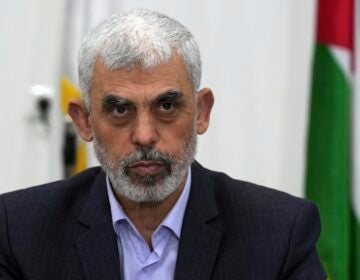Israel pounds Gaza neighborhoods, as people scramble for safety in sealed-off territory
If airstrikes continue, Gaza’s civilians will have fewer and fewer places to shelter as more neighborhoods become uninhabitable.
Israeli warplanes hammered the Gaza Strip neighborhood by neighborhood on Tuesday, reducing buildings to rubble and sending people scrambling to find safety in the tiny, sealed-off territory as Israel vowed a retaliation for Hamas’ surprise weekend attack that would “reverberate … for generations.”
Aid organizations pleaded for the creation of humanitarian corridors to get aid into Gaza, warning that hospitals overwhelmed with wounded were running out of supplies. Israel has stopped entry of food, fuel, and medicines into Gaza, and the sole remaining access from Egypt shut down Tuesday after airstrikes hit near the border crossing.
The war began after Hamas militants stormed into Israel on Saturday, bringing gunbattles to its streets for the first time in decades. More than 1,800 lives have already been claimed on both sides, and perhaps hundreds more. Hamas and other militant groups in Gaza hold more than 150 soldiers and civilians hostage, according to Israel.
The conflict is only expected to escalate. Israel expanded the mobilization of reservists to 360,000 on Tuesday, according to the country’s media. After days of fighting, Israel’s military said Tuesday morning that it had regained effective control over areas Hamas attacked in its south, and of the Gaza border.
A looming question is whether Israel will launch a ground offensive into Gaza — a 40 kilometer-long (25 mile-long) strip of land wedged among Israel, Egypt, and the Mediterranean Sea that is home to 2.3 million people and has been governed by Hamas since 2007.
On Tuesday, a large part of Gaza City’s Rimal neighborhood was reduced to rubble after warplanes bombarded it for hours the night before. Residents found buildings torn in half or demolished to mounds of concrete and rebar. Cars were flattened and trees burned out on residential streets transformed into moonscapes.
Palestinian Civil Defense forces pulled Abdullah Musleh out of his basement together with 30 others after their apartment building was flattened.
“I sell toys, not missiles,’’ the 46-year-old said, weeping. “I want to leave Gaza. Why do I have to stay here? I lost my home and my job.”
The Israeli military said it struck hundreds of targets in Rimal, an upscale district home to ministries of the Hamas-run government, universities, media organizations and the aid agency offices.
The devastation signaled what appeared to be a new Israeli tactic: warning civilians to leave certain areas and then hitting those areas with unprecedented intensity. On Tuesday afternoon, the military told residents of another nearby neighborhood to evacuate and move into the center of Gaza City.
“There is no safe place in Gaza right now, you see decent people being killed every day,” Hasan Jabar, a Gaza journalist, said after three other Palestinian journalists were killed in the Rimal bombardment. “I am genuinely afraid for my life.”
Tuesday afternoon, Hamas fired barrages of rockets toward the southern Israeli city of Ashkelon and Tel Aviv. There were no immediate reports of casualties.
The bombardments and Israel’s threats to topple Hamas sharpened questions about the group’s strategy and objectives. But it is unclear what options it has in the face of the ferocity of Israel’s retaliation and the potential of losing much of its government infrastructure.
Hours after Saturday’s incursion began, a senior Hamas official Saleh al-Arouri said the group had planned for all possibilities, including “all-out war,” and was ready to suffer “severe blows.”
Desperation has grown among Palestinians, many of whom see nothing to lose under unending Israeli control and increasing settlements in the West Bank, the blockade in Gaza and what they see as the world’s apathy.
Al-Arouri’s comments suggested Hamas expected the fight to spread to the West Bank and possibly for Lebanon’s Hezbollah to open a front in the north. But despite some eruptions of violence, neither has happened on a significant scale, especially amid a heavy Israeli lockdown on West Bank Palestinians.
In hopes of blunting the bombardment, Hamas has threatened to kill one Israeli civilian captive any time Israel targets civilians in their homes in Gaza “without prior warning.” Israel’s foreign minister, Eli Cohen, warned in response that “this war crime” would not be forgiven.
Israel, in turn, appears determined to crush Hamas no matter the cost.
The militants’ attack stunned Israel with a death toll unseen since the 1973 war with Egypt and Syria — and those deaths happened over a longer period of time. It brought horrific scenes of Hamas militant gunning down civilians in their cars on the road, in streets of towns, and at a music festival attended by thousands in the desert near Gaza, while dragging men, women and children into captivity.
U.S. President Joe Biden is scheduled to speak Tuesday with Prime Minister Benjamin Netanyahu about coordination with allies to “defend Israel and innocent people against terrorism,” the White House said.
The Israeli military said Tuesday that more than 1,000 people have been killed in Israel. In Gaza and the West Bank, 830 people have been killed, according to authorities there; Israel says hundreds of Hamas fighters are among them. Thousands have been wounded on both sides.
The bodies of roughly 1,500 Hamas militants were found on Israeli territory, the military said. It wasn’t immediately clear whether those numbers overlapped with deaths previously reported by Palestinian authorities.
In Gaza, more than 187,000 people have fled their homes, the U.N. said, the most since a 2014 air and ground offensive by Israel uprooted about 400,000. The vast majority are sheltering in schools run by UNRWA, the U.N. agency for Palestinian refugees. Damage to three water and sanitation sites have cut off services to 400,000 people, the U.N. said.
On Monday, Israel announced a “complete siege” on the territory, halting deliveries of food, fuel, water, medicines, electricity and other supplies. That leaves the only access in and out through the Rafah crossing with Egypt.
But that too was shut down Tuesday after Israeli strikes raised palls of smoke nearby and sent families waiting with suitcases for a chance to get out running for cover. A day earlier, the Egyptian Red Crescent managed to get in one shipment of medical supplies.
Egyptian officials were talking with Israel and the U.S., pushing to set up humanitarian corridors in Gaza to deliver aid, an Egyptian official said. There were negotiations with the Israelis to declare the area around the Rafah crossing between Egypt and Gaza as a “no fire zone,” the official said, speaking on condition of anonymity because he was not authorized to talk to the media.
The U.N.’s World Health Organization echoed the call for humanitarian corridors. It said that supplies it had pre-positioned for seven hospitals in Gaza have already run out amid the flood of wounded.
“With the number of casualties currently coming in, these hospitals are now running beyond their capacity,” WHO spokesman Tarik Jazarevic told reporters in Geneva. The head of the medical aid group Doctors Without Borders said surgical equipment, antibiotics, fuel and other supplies were running out at two hospitals it runs in Gaza as well.
In a briefing Tuesday, army spokesperson Lt. Col. Richard Hecht suggested Palestinians should try to leave through the Rafah border crossing with Egypt.
The prospect of an exodus of Gazans into its territory has alarmed Egyptian officials. After Hecht’s comments, the Egyptian state-owned Al-Qahera news channel, which is close to security agencies, quoted an unnamed security official pushing back. “The occupation government is forcing Palestinians to choose between dying under bombardment or leaving their land,” the official was quoted as saying.
Meanwhile in the West Bank, Palestinians entered a fourth day under severe movement restrictions. Israeli authorities have sealed off crossings to the occupied territory and closed checkpoints, blocking movement between cities and towns. Clashes between rock-throwing Palestinians and Israeli forces in the territory since the start of the incursion have left 15 Palestinians dead, according to the U.N.
___
Adwan reported from Rafah, Gaza Strip. AP writers Isabel DeBre and Julia Frankel in Jerusalem; Wafaa Shurafa in Gaza City; Tia Goldenberg in Tel Aviv, Israel; Bassem Mroue and Kareem Chehayeb in Beirut; Samy Magdy in Cairo; and Amir Vahdat in Tehran, Iran, contributed to this report.
WHYY is your source for fact-based, in-depth journalism and information. As a nonprofit organization, we rely on financial support from readers like you. Please give today.





